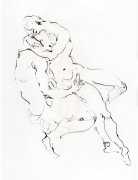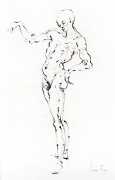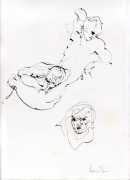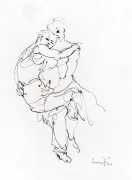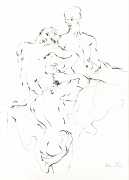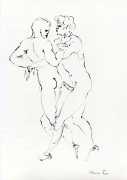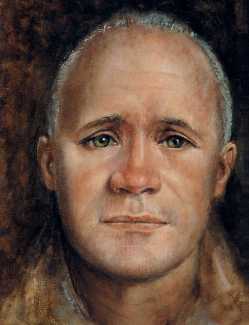
Leonor Fini met Jean Genet, the enfant terrible of French literature and radical politics, in the early 1940s, and was drawn to his dissident views and his open homosexuality. She already knew Genet’s publisher, Jacques Loyau, who was also a dealer in antiquarian books and had supplied her with old volumes on anatomy, strange monsters, and other such subjects that she loved to collect. At Genet’s suggestion, in 1947 Loyau invited Leonor to illustrate Genet’s La galère (The Galley), about a virile murderer who is transformed into a tragic ‘queen’ in a fantasy involving a galley ship transporting prisoners to a penal colony in Guyana.
Leonor made six quite freely drawn etchings of explicit sexual activities between men. Genet was delighted, and presented her with a copy of his book Pompes funèbres (Funeral Rites) of 1947, inscribed ‘To Leonor, in whose spirit and heart I lie down, rest, and go to sleep. With all my trust, Jean.’ In 1956 Genet was given a fine and a suspended prison sentence for publishing two works that were ‘in contempt of morality’, the illustrated editions of La galère and Querelle de Brest (illustrated by Jean Cocteau, which you can see here), even though both books had been available in above-the-counter editions for two years. Whereas Cocteau’s drawings for Querelle were clearly more explicit than those of Leonor for La galère, both artists were presumed to be complicit in the offence, although neither was prosecuted.
In the late summer of 1947 Loyau had asked Leonor to continue her collaboration with Genet by illustrating his allusive and symbolic poem Le Chant d’amour (The Song of Love), written for his lover Lucien Sénémaud. Although the poem was not explicit in its homosexual content, Loyau suggested a series of images of homosexual activities stronger even than those she had made for La galère, and he hoped for more precision in the technique. Leonor initially agreed, and aware of her interest in homosexual men, Loyau wrote her a letter describing in the most explicit detail his own sexual exploits with sailors in the seaside town of Dinard. Leonor was fascinated and suggested that an English photographer friend of hers should photograph Loyau’s lovers so as to provide her with visual inspiration: ‘We must have some boys with fake tattoos. We must find very sordid apartments, filthy doctors’ waiting rooms, and other places redolent of old-fashioned lust. We must not forget urinals and brothels, and also bistros where people play with each other under the tables.’ Unfortunately, Leonor was taken ill soon afterwards and the whole project came to nothing.
Leonor Fini’s illustrations for La galère are particularly notable for being one of the very few times a woman has illustrated a male gay text. Compared with the number of male illustrators who have given rein to their lesbian fantasies, female illustrators imagining gay intimacy can almost be counted on the fingers of one finger.
Paraphrased from Peter Webb’s Sphinx: The Life and Art of Leonor Fini.


